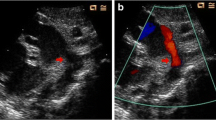Abstract
Minimally invasive surgery is widely used in pediatric surgery. Extremely low birth weight infants (ELBWI) are literally so fragile to surgical stress that the minimum invasive procedures should be required. We report 15 ELBWI cases with patent ductus arteriosus (PDA), who underwent surgical closure. All of them had failed treatment with indomethacin to close PDA or had contraindicated to its use. The mean gestational age at birth was 26.0±2.7 weeks (24–34 weeks) and birth weight 702±140 g (479–966 g). The mean age at operation was 23±11 days (2–48 days) and body weight at operation 679±151 g (428–969 g). The surgery-related mortality was none. No complications were also encountered. Our surgical procedures consist of 2 modalities, one is clipping PDA, not ligation. Clipping technique attributes to minimize the dissection of surrounding tissue of PDA. The other is posterolateral muscle sparing thoracotomy, which would reduce long-term physical impairment and deformity. We believe our surgical technique can be accomplished safely and would be an alternative approach for ELBWI with a lower probability of PDA closure with indomethacin or an increased risk of complications for medical treatment.
Similar content being viewed by others
References
Horiuchi T, Ohno T, Itani Y, Kabe K, Nakamura T, Nakamura H. Studies on the states of care for high risk neonates and neonatal mortality in our country (2000). J Jpn Pediatr Soc 2002; 106: 603–13.
Kida Y. Extremely low birth weight infants and cerebral palsy (in Japanese). Pediatr Jpn 2002; 43: 795–802.
Kawakita M, Matsuzawa S, Toshima K. How to deal with patent ductus arteriosus (in Japanese). J Pediatr Practice 2003; 66: 445–50.
Weiss H, Cooper B, Brook M, Schlueter M, Clyman R. Factors determining reopening of the ductus arteriosus after successful clinical closure with indomethacin. J Pediatr 1995; 127: 466–71.
Traugott RC, Will RJ, Schuchmann GF, Treasure RL. A simplified method of ligation of patent ductus arteriosus in premature infants. Ann Thorac Surg 1980; 29: 263.
Kron IL, Mentzer RM Jr, Rheuban KS, Nolan SP. A simple, rapid technique for operative closure of patent ductus arteriosus in the premature infant. Ann Thorac Surg 1984; 37: 422.
Niinikoski H, Alanen M, Parvinen T, Aantaa R, Ekblad H, Kero P. Surgical closure of patent ductus arteriosus in very-low-birth-weight infants. Pediatr Surg Int 2001; 17: 338–41.
Eggert LD, Jung AJ, McGough EC, Ruttenberg HD. Surgical treatment of patent ductus arteriosus in preterm infants. Four-year experience with ligation in the newborn intensive care unit. Pediatr Cardiol 1982; 2: 15–8.
Perez CA, Bustorff-Silva JM, Villasenor E, Fonkalsrud EW, Atkinson JB. Surgical ligation of patent ductus arteriosus in very low birth weight infants: Is it safe? Am Surg 1998; 64: 1007–9.
Strange MJ, Myers G, Kirklin JK, Pacifico A, Braune K, Philips J, et al. Surgical closure of patent ductus arteriosus does not increase the risk of intraventricular hemorrhage in the preterm infant. J Pediatr 1985; 107: 602–4.
Cassady G, Crouse DT, Kirklin JW, Strange MJ, Joiner CH, Godoy G, et al. A randomized, controlled trial of very early prophylactic ligation of the ductus arteriosus in babies who weighed 1000 g or less at birth. N Engl J Med 1989; 320: 1511–6.
Canarelli JP, Poulain H, Clamadieu C, Ricard J, Maingourd Y, Quintard JM. Ligation of the patent ductus arteriosus in premature infants: Indications and procedures. Eur J Pediatr Surg 1993; 3: 3–5.
Trus T, Winthrop AL, Pipe S, Shah J, Langer JC, Lau GY. Optimal management of patent ductus arteriosus in the neonate weighing less than 800 g. J Pediatr Surg 1993; 28: 1137–9.
Panagopoulos PG, Tatooles CJ, Aberdeen E, Waterston DJ, Carter RE. Patent ductus arteriosus in infants and children: A review of 936 operations (1946–69). Thorax 1971; 26: 137–44.
Trippestad A, Efskind L. Patent ductus arteriosus. Surgical treatment of 686 patients. Scand J Thorac Cardiovasc Surg 1972; 6: 38–42.
Mavroudis C, Backer CL, Gevitz M. Forty-six years of patient ductus arteriosus division at Children's Memorial Hospital of Chicago. Standards for comparison. Ann Surg 1994; 220: 402–9.
Sorensen KE, Kristensen B, Hansen OK. Frequency of occurrence of residual ductal flow after surgical ligation by color-flow mapping. Am J Cardiol 1991; 67: 653–4.
Fan LL, Campbell DN, Clarke DR, Washington RL, Fix EJ, White CW. Paralyzed left vocal cord associated with ligation of patent ductus arteriosus. J Thorac Cardiovasc Surg 1989; 98: 611–3.
Miles RH, DeLeon SY, Muraskas J, Myers T, Quinones JA, Vitullo DA, et al. Safety of patent ductus arteriosus closure in premature infants without tube thoracostomy. Ann Thorac Surg 1995; 59: 668–70.
Rashkind WJ, Cuaso CC. Transcatheter closure of patent ductus arteriosus: Successful use in a 3.5 kilogram infant. Pediatr Cardiol 1979; 1: 3–7.
Haneda N, Masue M, Tasaka M, Fukui C, Saito K, Yamaguchi S. Transcatheter closure of patent ductus arteriosus in an infant weighing 1180 g. Pediatr Int 2001; 43: 176–8.
Forster R. Thoracoscopic clipping of patent ductus arteriosus in premature infants. Ann Thorac Surg 1993; 56: 1418–20.
Ashour M. Modified muscle spairing posterolateral thoracotomy. Thorax 1990; 45: 935–8.
Jawad AJ. Experience with modified posterolateral muscle-sparing thoracotomy in neonates, infants, and children. Pediatr Surg Int 1997; 12: 337–9.
Author information
Authors and Affiliations
Rights and permissions
About this article
Cite this article
Iwase, J., Tajima, K., Io, A. et al. Less invasive surgical closure of patent ductus arteriosus in extremely low birth weight infants. Jpn J Thorac Caridovasc Surg 51, 651–655 (2003). https://doi.org/10.1007/s11748-003-0003-x
Received:
Accepted:
Published:
Issue Date:
DOI: https://doi.org/10.1007/s11748-003-0003-x




